Ukraine in maps: Tracking the war with Russia
- Published
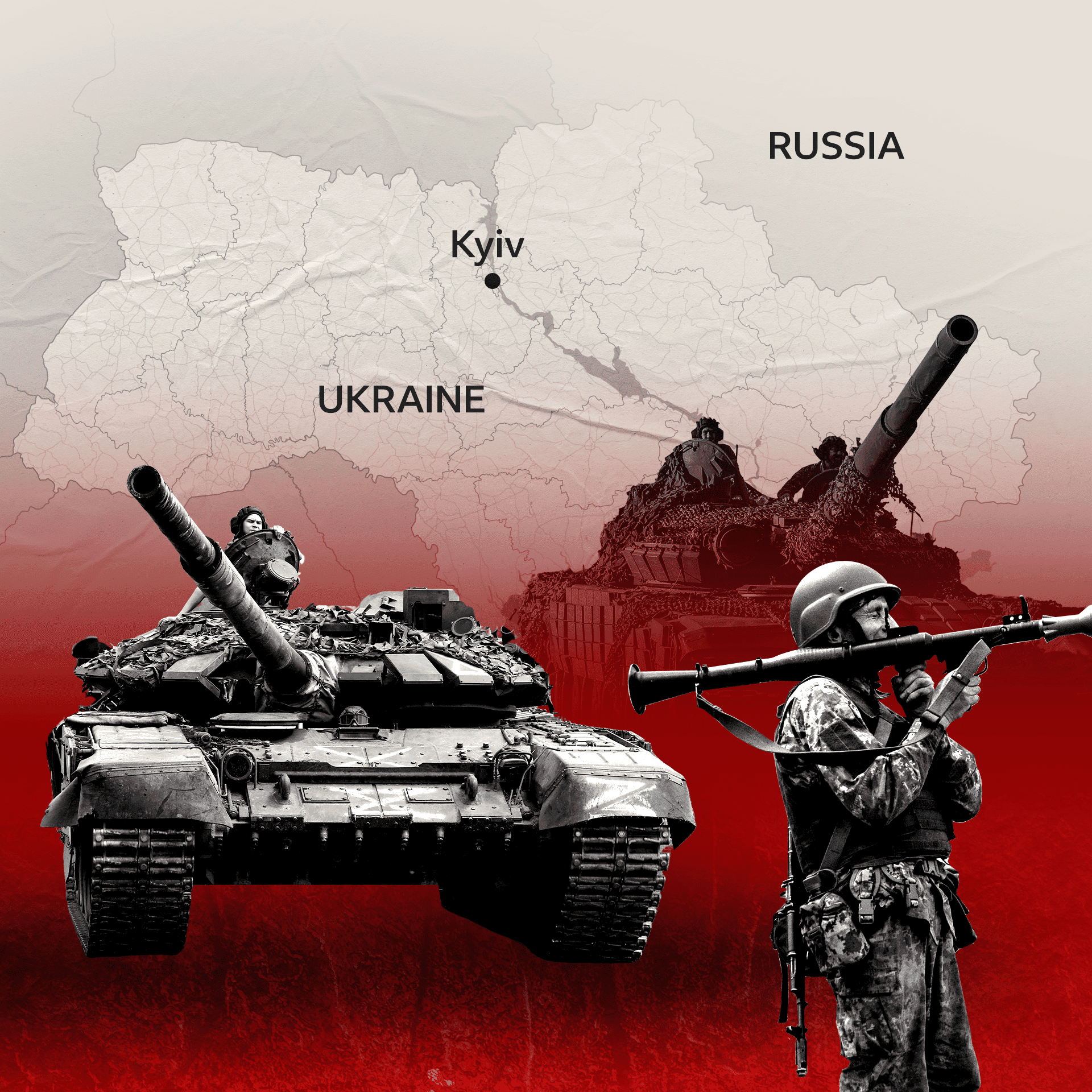
Fighting has raged in Ukraine since Russia launched a full-scale invasion more than three years ago. Over the past year, Russian forces have slowly expanded the amount of territory they control, mostly in the east of Ukraine, and have continued their recent barrage of air strikes on Kyiv and other cities.
Talks have taken place between Ukraine and the US in Geneva, Switzerland, after an initial US-backed draft peace plan was criticised in Kyiv and Europe for being too favourable to Russia.
However, the gap between the terms that Ukraine and Russia will accept is still very wide and the Kremlin is unlikely to agree to the kind of deal that Kyiv may approve.
With President Volodymyr Zelensky now seeking fresh talks with US President Donald Trump, here's a look at the situation on the ground in Ukraine.
Russia grinds forward in the east
In eastern Ukraine, Moscow's war machine has been churning mile by mile through the wide open fields of the Luhansk and Donetsk regions - also known as the Donbas - surrounding and overwhelming villages and towns.
It has been trying to gain full control of the area along with two more regions to the west - Zaporizhzhia and Kherson. Shortly after the invasion, Russia held referendums to try to annexe all these regions - in the same way it had annexed Crimea in 2014 - but it has never had them under full control.
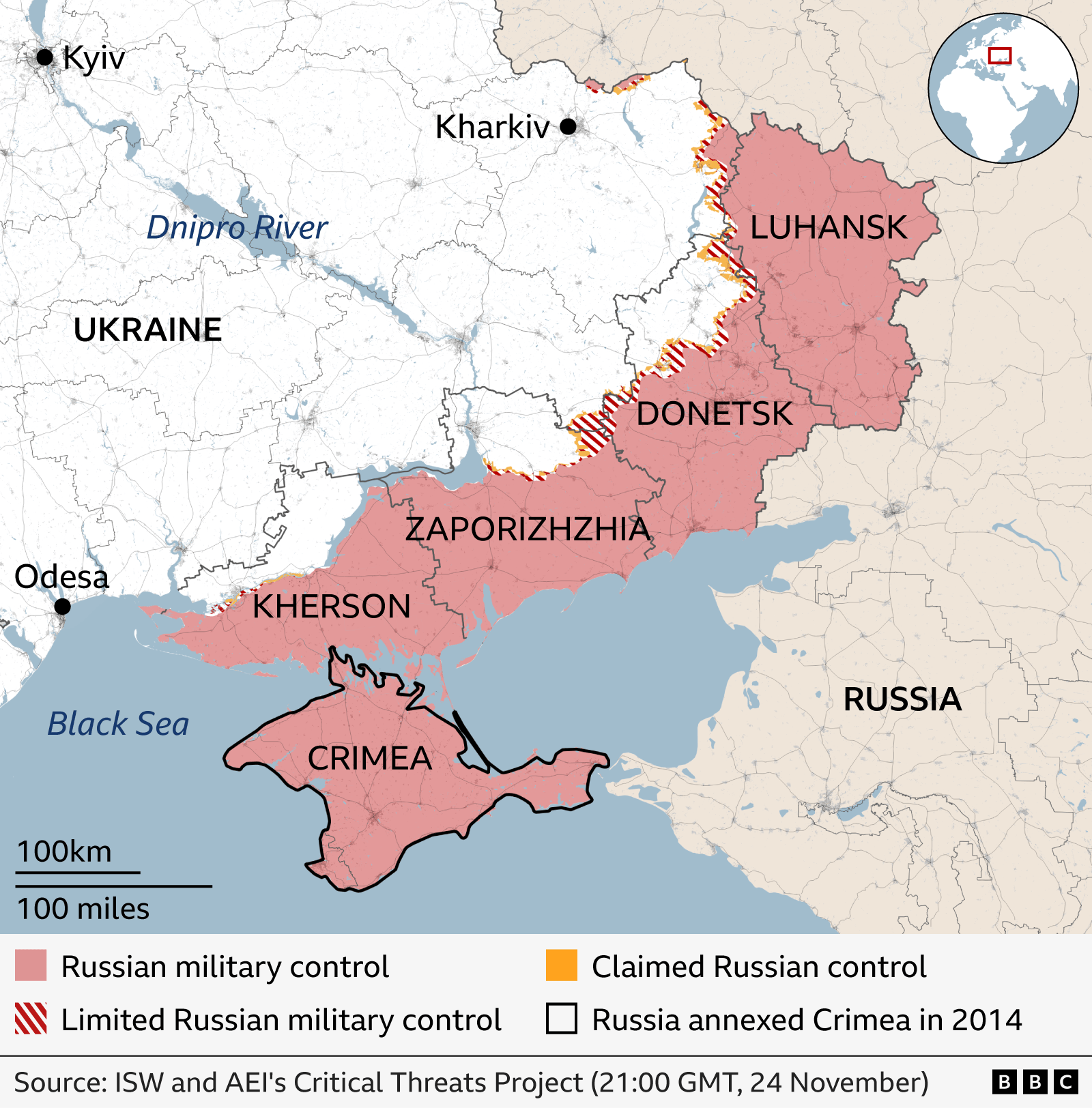
Under the initial peace plan - drafted by US and Russian officials last month – Ukraine would cede control of all of Luhansk, Donetsk and Crimea, along with the areas of Zaporizhzhia and Kherson Russia currently occupies, to Moscow.
Ukrainian forces would have to withdraw from parts of Donetsk they still hold and this would become a demilitarised area under de facto Russian control. Russian forces would withdraw from the small areas of Ukraine they currently occupy outside those regions.
Zelensky has consistently said Ukraine will not hand over the Donbas in exchange for peace, saying such a concession could be used as a springboard for future attacks by Russia.
Key towns targeted
A recent report by the US-based Institute for the Study of War, (ISW) describes a "fortress belt" running 50km (31 miles) through western Donetsk.
"Ukraine has spent the last 11 years pouring time, money, and effort into reinforcing the fortress belt and establishing significant defence industrial and defensive infrastructure," it writes.
The area also includes big cities that are still under Ukrainian control, including Druzhkivka, Kramatorsk and Slovyansk.
A Russian summer offensive near the eastern town of Pokrovsk did make rapid advances just north of the town and Russia has recently made advances in the south of the town itself and to the east of nearby Kostyantynivka.
Analysts say Ukrainian forces maintain a "limited presence" in Pokrovsk itself and continue to mount counterattacks "indicating that Russian forces likely remain unable to rapidly seize Pokrovsk at this time".
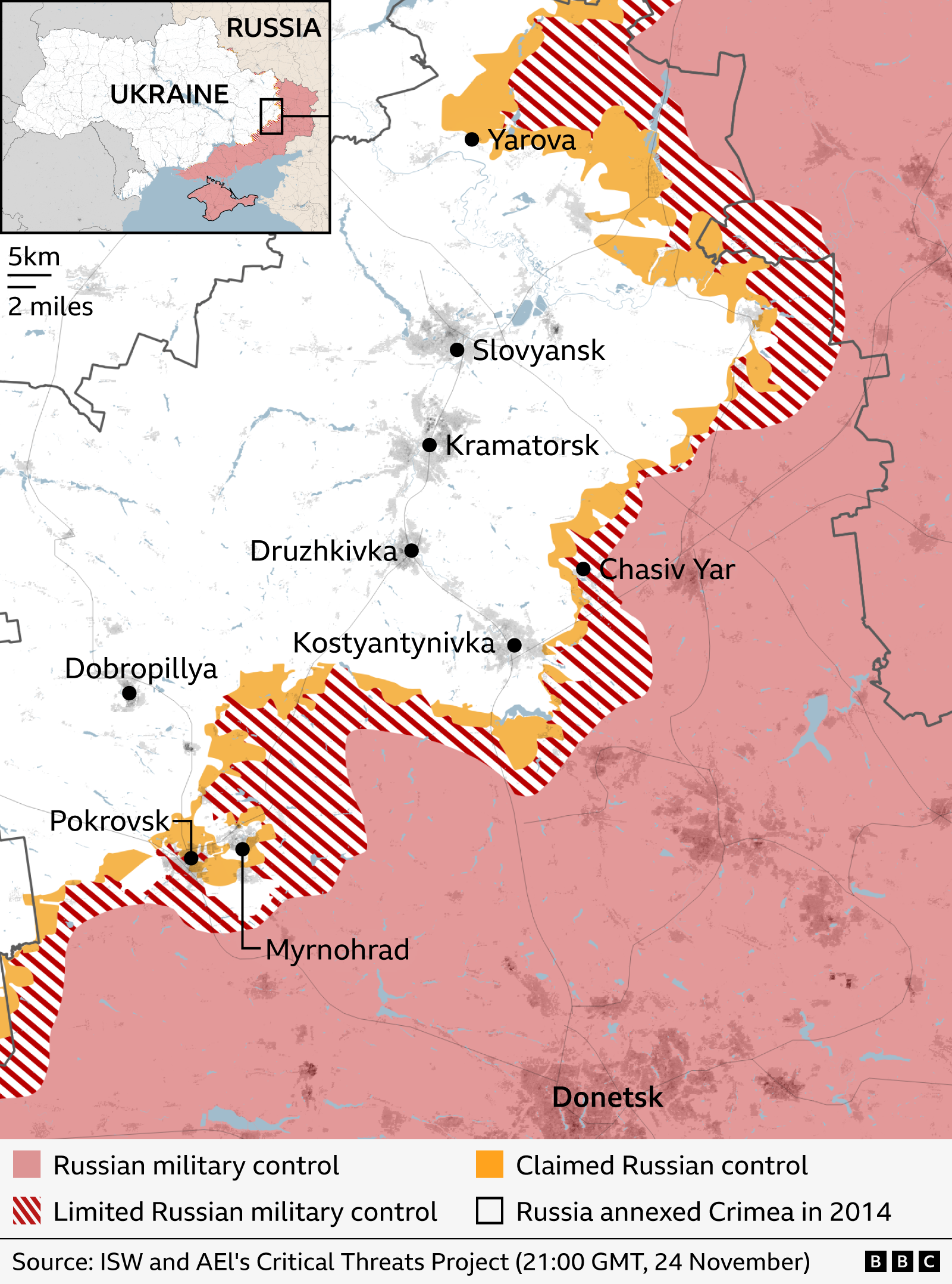
The ISW says it would take Russia "several years" to complete its objective in the region.
However, it also notes that Russia's casualty rates have fallen in recent months despite its more rapid advances and says this is likely to be the result of its increased use of unmanned aerial vehicles - drones.
Russian incursion north of Kharkiv
Further north, Russia has been pushing towards Kupyansk in east of the Kharkiv region, as part of its efforts to capture the whole of Luhansk and encircle northern Donetsk.
Its defence ministry has said that if it seizes Kupyansk it will use this as a foothold to make further advances into the Kharkiv region.
And in addition to the eastern front, in May 2024 Russia began what the ISW describes as its "subordinate main effort", when it crossed the border to the north of Ukraine's second-biggest city, Kharkiv.
Several villages were seized and thousands of civilians fled.
Recent ISW analysis of the area shows Russia has advanced near Vovchansk and Lyptsi as it tries to create a buffer zone inside Ukraine's northern borders and get within artillery range of Kharkiv.
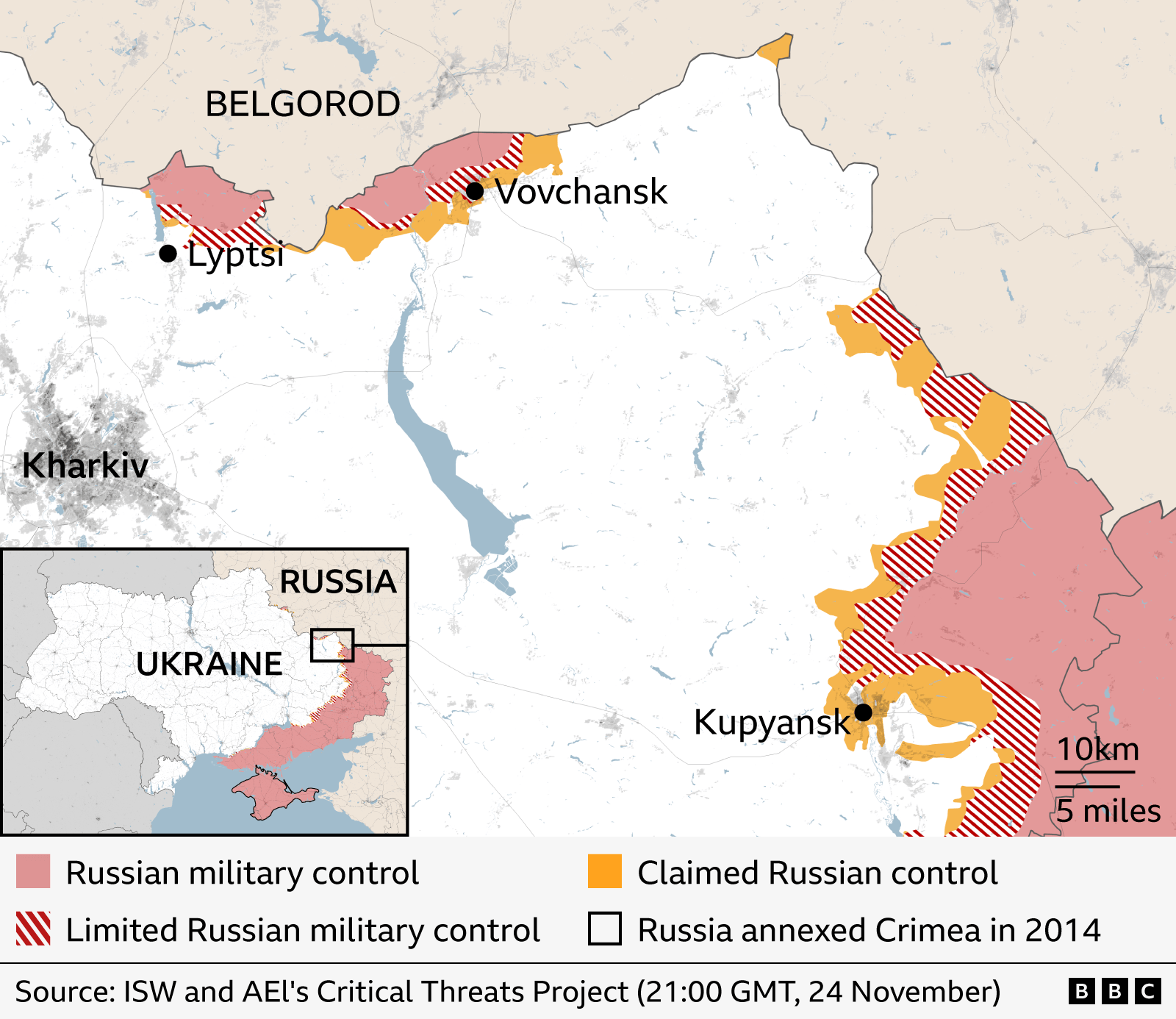
Putin says he wants this buffer zone to protect Russia, after Ukrainian forces captured a swathe of territory further north in Kursk last summer. Russian forces eventually drove them out, with the help of North Korean troops.
The Russians then pushed on into Ukraine but quickly became bogged down in fighting over small border villages, which keep changing hands even today. Without major reinforcements, it is unlikely Russian troops will advance much further.
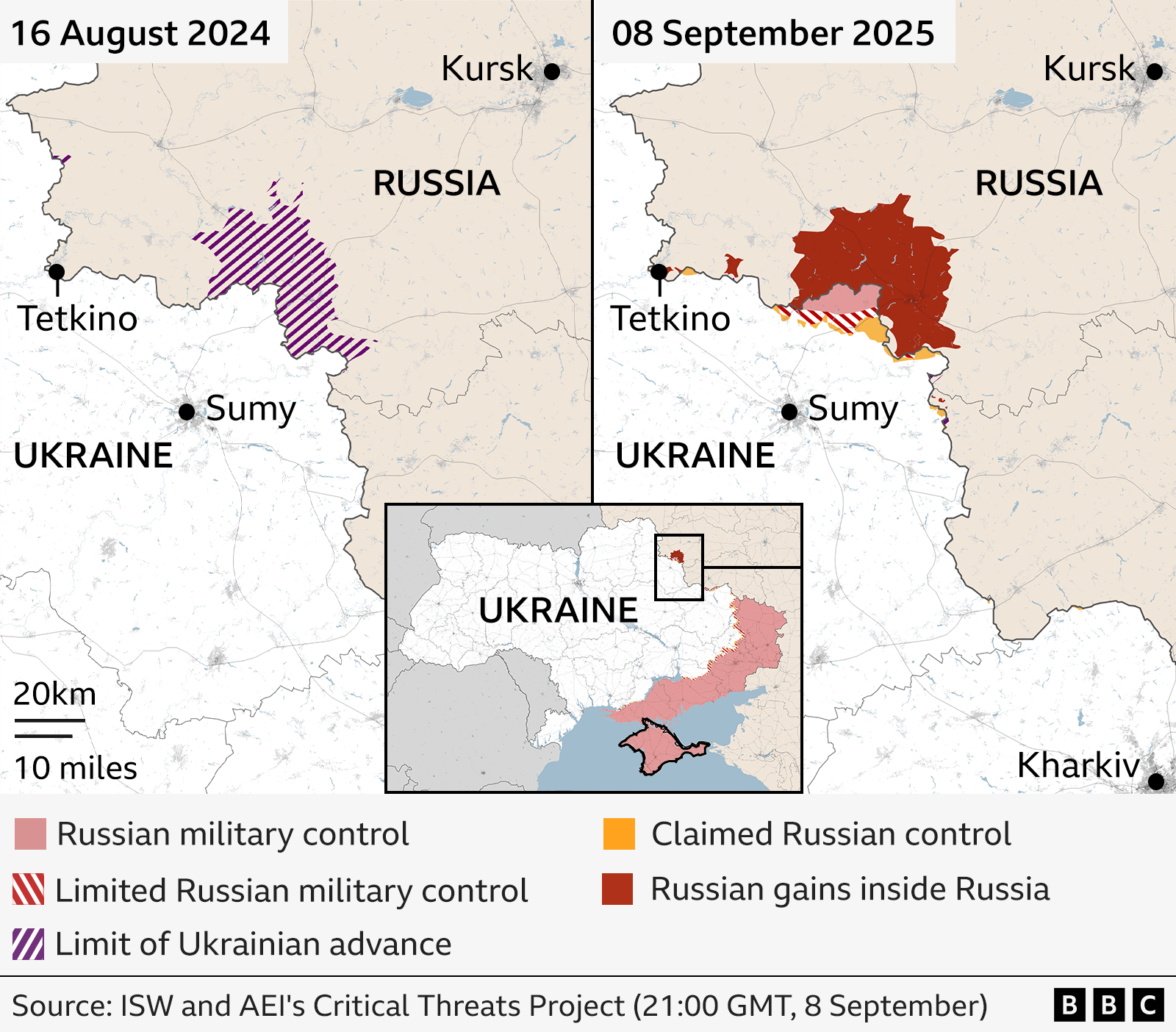
As well as the counter-offensive in the Kursk region, Ukraine has struck air bases deep inside Russia. One of these attacks involved using 100 drones to target nuclear-capable long-range bombers.
The Russian Defence Ministry confirmed the attacks had occurred in five regions of Russia - Murmansk, Irkutsk, Ivanovo, Ryazan and Amur - but stated planes had been damaged only in Murmansk and Irkutsk, while in other locations the attacks had been repelled.
Kyiv claims the drone operation inflicted $7bn (£5.2bn) of damage to the Russian military. It hasn't been possible to verify either country's claims.
More recently Moscow blamed Ukrainian drones for a massive oil depot fire near Russia's Black Sea resort of Sochi - the venue of the 2014 Winter Olympic Games.
Ceasefire talks
Since Trump took office at the start of 2025, the US has been pursuing an end to the war - now in its fourth year - through negotiations.
Trump had been seen as more sympathetic to Russia than his predecessor Joe Biden was, and strained relations with Zelensky came to a head on 28 February when he and Vice-President JD Vance berated the Ukrainian president in the Oval Office on live television.
Public relations with Zelensky have vastly improved in recent months and Ukraine remains critically dependent on deliveries of US-made advanced weaponry, including air defence systems to repel deadly Russian air assaults, as well as intelligence provided by Washington.
Zelensky warned that Kyiv risked losing US support over the latest peace plan - the draft, in addition to ceding territory, would have required Ukraine to significantly cut the size of its army size and pledge not to join Nato.
Since then, talks have taken place between the US and Ukraine in Geneva with officials on both sides suggesting progress has been made - although the details have not been released and Russia has not been involved.
Three years of fighting
Russia's full-scale invasion began with dozens of missile strikes on cities all over Ukraine before dawn on 24 February 2022.
Russian ground troops moved in quickly and within a few weeks were in control of large areas of Ukraine and had advanced to the suburbs of Kyiv.
Russian forces were bombarding Kharkiv, and had taken territory in the east and south as far as Kherson, and surrounded the port city of Mariupol.
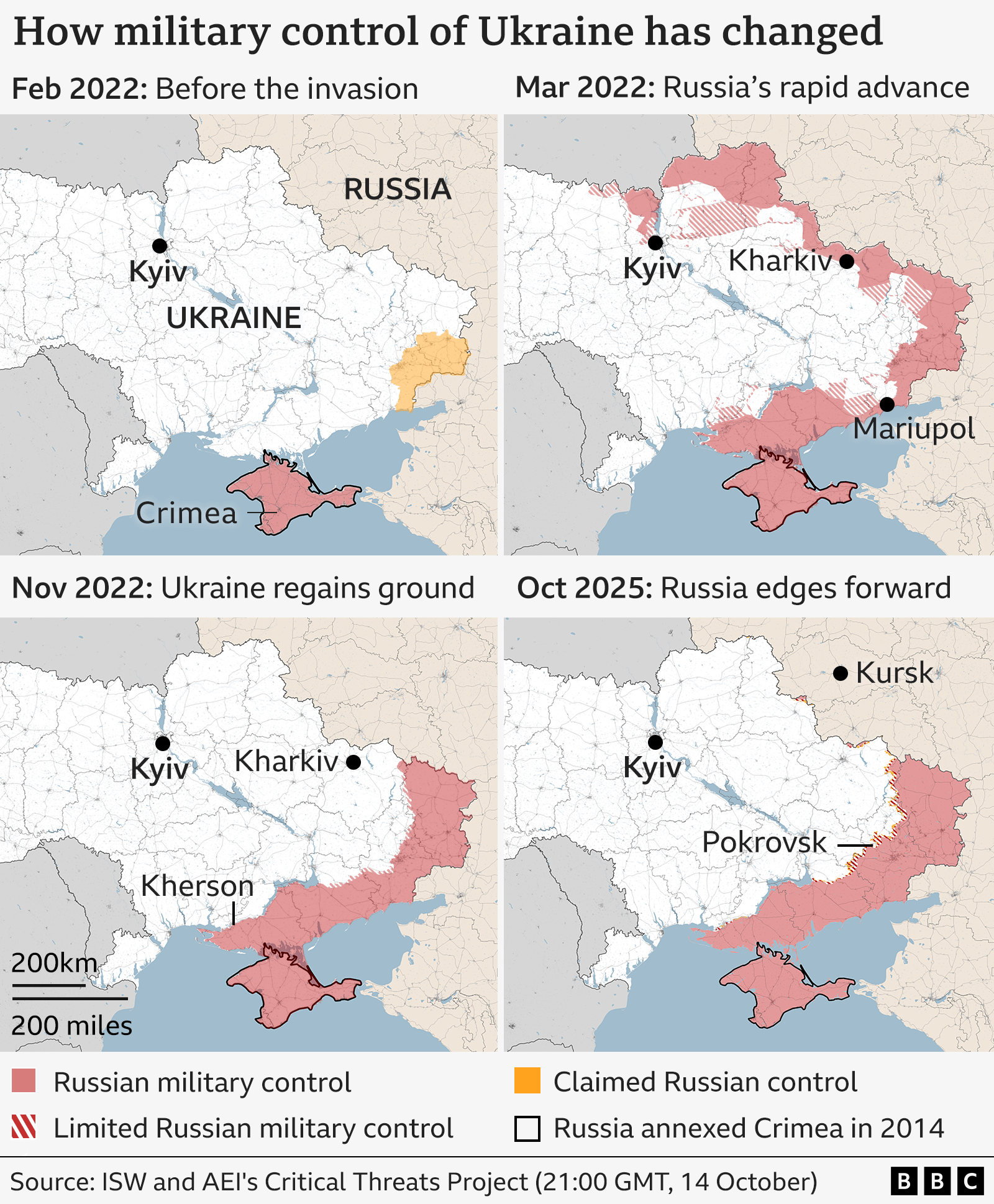
But they hit very strong Ukrainian resistance almost everywhere and faced serious logistical problems with poorly-motivated Russian troops suffering shortages of food, water and ammunition.
Ukrainian forces were also quick to deploy Western supplied arms such as the Nlaw anti-tank system, which proved highly effective against the Russian advance.
By October 2022, the picture had changed dramatically and, having failed to take Kyiv, Russia withdrew completely from the north. The following month, Ukrainian forces recaptured the southern city of Kherson.
Since then, the battle has mostly been in the east of Ukraine with Russian forces slowly gaining ground over many months - military experts estimate between 165,000 and 235,000 Russian service personnel have been killed since the invasion.
Ukraine last updated its casualty figures in December 2024, when President Zelensky acknowledged 43,000 Ukrainian deaths among soldiers and officers. Western analysts believe this figure to be an under-estimate.
By Dominic Bailey, Mike Hills, Paul Sargeant, Chris Clayton, Kady Wardell, Camilla Costa, Mark Bryson, Sana Dionysiou, Gerry Fletcher, Kate Gaynor and Erwan Rivault
About these maps
To indicate which parts of Ukraine are under control by Russian troops we are using daily assessments published by the Institute for the Study of War, external with the American Enterprise Institute's Critical Threats Project, external.
The situation in Ukraine is often fast moving and it is likely there will be times when there have been changes not reflected in the maps.